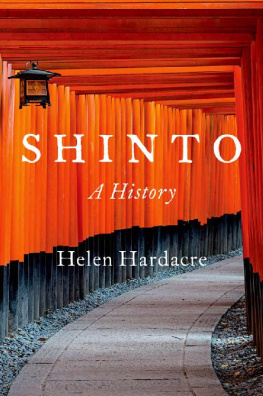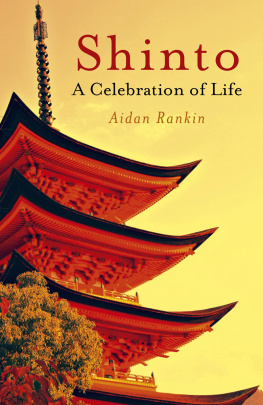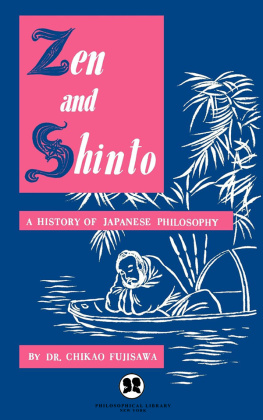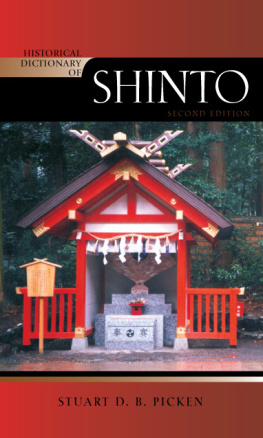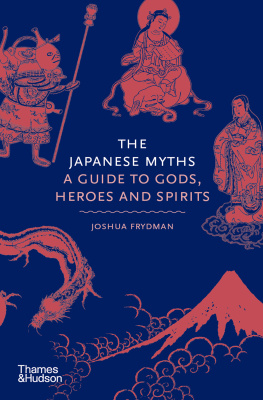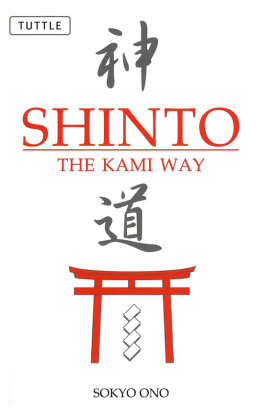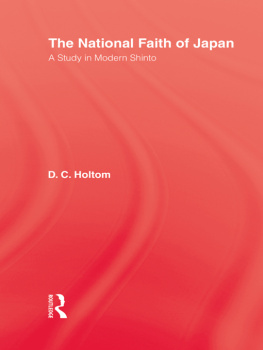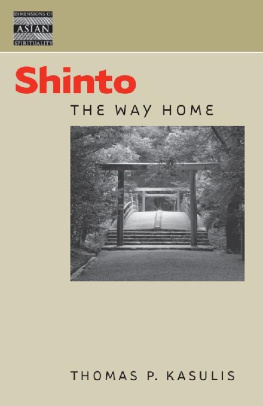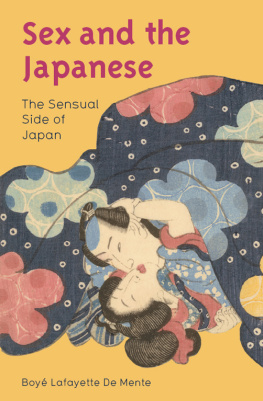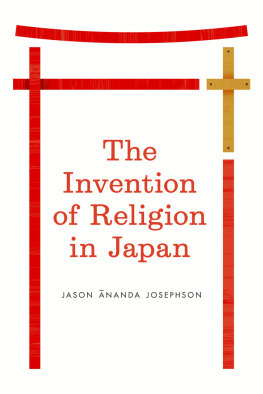Shinto
Shinto
A History
HELEN HARDACRE


Oxford University Press is a department of the University of Oxford. It furthers the Universitys objective of excellence in research, scholarship, and education by publishing worldwide. Oxford is a registered trade mark of Oxford University Press in the UK and certain other countries.
Published in the United States of America by Oxford University Press
198 Madison Avenue, New York, NY 10016, United States of America.
Oxford University Press 2017
All rights reserved. No part of this publication may be reproduced, stored in a retrieval system, or transmitted, in any form or by any means, without the prior permission in writing of Oxford University Press, or as expressly permitted by law, by license, or under terms agreed with the appropriate reproduction rights organization. Inquiries concerning reproduction outside the scope of the above should be sent to the Rights Department, Oxford University Press, at the address above.
You must not circulate this work in any other form and you must impose this same condition on any acquirer.
Library of Congress Cataloging-in-Publication Data
Names: Hardacre, Helen, 1949
Title: Shinto : a history / Helen Hardacre.
Description: New York : Oxford University Press, 2016. | Includes bibliographical references and index.
Identifiers: LCCN 2016021265 (print) | LCCN 2016024681 (ebook) | ISBN 9780190621711 (cloth : alk. paper) | ISBN 9780190621728 (updf) | ISBN 9780190621735 (epub)
Subjects: LCSH: ShintoHistory.
Classification: LCC BL2218 .H37 2016 (print) | LCC BL2218 (ebook) | DDC 299.5/6109dc23
LC record available at https://lccn.loc.gov/2016021265
For Linda
CONTENTS
While conducting research for this book, I accumulated numerous, heavy debts. I received extensive financial support and collegial encouragement from the Edwin O. Reischauer Institute of Japanese Studies, Harvard University. The Reischauer Institute enabled me to have the manuscript read and critiqued by specialists. I would like to thank Gary Ebersole for his comments on chapters regarding the ancient period, Fabio Rambelli for his critique of the chapters concerning the medieval age, Anne Walthall for her comments on the chapters about the early modern period, and Inoue Nobutaka for his critique of the chapters on the modern period. Joan Piggott, Susan Napier, and Alexander Zahlten also took the time to comment on portions of the text. Each of these colleagues made extensive comments that enabled me to redraft the material and avoid a variety of errors. Those that remain are my responsibility, it goes without saying.
The Reischauer Institutes provisions for faculty exchange with Kokugakuin University have brought Shinto specialists to Harvard annually, and the chance to learn from them has been tremendously helpful to me. I am especially indebted to the late Abe Yoshiya, who originally proposed the exchange, as well as Miyake Hitoshi, Suga Kji, Hoshino Seiji, and Dait Takaaki. Besides their many kindnesses to me, Professors Suga, Hoshino, and Dait have continued to guide Harvard students since their time in residence.
From May 2003 through May 2004, I had the opportunity to conduct participant observation research at the kunitama Shrine, Fuch City, Tokyo Prefecture, supported by a John Simon Guggenheim Fellowship. This research period at the shrine came after earlier visits in 1998 and 1999, and was followed by several subsequent opportunities to observe the shrines rituals and festivals. My long-term mentor, Professor Miyake Hitoshi of Kei and Kokugakuin Universities, kindly arranged an introduction to the shrines Head Priest Sawatari Masamori. My year at the kunitama Shrine was crucially important in affording me many opportunities to interact with the full range of people who support community shrines, including priests, shrine stewards, community groups that manage the shrines eight mikoshi and their huge drums, the decorated floats maintained by young men and children who dance and play festival music (hayashi) on the float stages, related shrines that have various roles in kunitama Shrines Annual Festival, numerous officials of Fuch City who regard the shrine as the towns public face, and local businessmen who provide the core of the shrines support. I am particularly grateful to Head Priest Sawatari and his colleague Matsumoto Masashi, now Negi, at the shrine, for their generosity of spirit, as well as the many hours they spent with me, and their permission for me to observe and document so many aspects of shrine life.
I am likewise indebted to Kurozumi Muneharu, Patriarch of Kurozumiky. His permission for me to research Kurozumiky early in my studies of Shinto gave me an unparalleled opportunity to understand the devotional aspects of Shinto and to understand how new religious movements derived from Shinto relate to other sectors of the tradition. Reverend Kurozumi, his mother, wife, and sons, and the Fukumitsu family of the i Church of Kurozumiky have my deepest gratitude for thirty-five years of an extraordinary friendship and for their many kindnesses to Harvard students.
Many librarians contributed to my research, beginning with Kuniko Yamada McVey and James Cheng of the Harvard-Yenching Library. I also received significant assistance from the librarians of Kanagawa, Tokyo, Yamagata, Hokkaid, Shimane, Okayama, Fukui, Ishikawa, Toyama, Shiga, Kyoto, Osaka, Shizuoka, Yamaguchi, Fukuoka, Nagasaki, Saga, Oita, Mie, Aichi, Wakayama, Nara, and Hiroshima Prefectures. I would also like to acknowledge the kindness of the Shinto Museum at Kokugakuin University in allowing me to reprint items from its holdings, as well as Paul Swanson, Editor of Japanese Journal of Religious Studies and Bettina Gramlich-Oka, Editor of Monumenta Nipponica, for their kind permission to use images from these journals. In addition, I am most grateful to Sarah Thompson, Curator, Japanese Art, of the Museum of Fine Arts, Boston, who helped me identify the images from the museums collections that appear in this book, and Rachel Saunders, Abby Aldrich Rockefeller Associate Curator of Asian Art, Harvard Art Museums, who helped me acquire several illustrations from Harvards collections.
Opportunities to co-teach seminars with Harvard colleagues and historians of art, Melissa McCormick and Yukio Lippit, gave me many new insights into the importance of the arts and aesthetics in Shinto. Their work continues to inspire me.
I also wish to acknowledge my reliance on the work of Kuroda Toshio, Allan Grapard, and Mark Teeuwen. Each of them has set tremendously challenging standards for research on Shinto.
Over the years of working on this book, many Harvard students contributed to my research. Discussions with the students in a 2010 course on Japanese folk religious traditions were especially important, and I would like to thank Ben Cox, Christina Fanciullo, Christian Greer, Harry Huberty, Tim Lehmann, Ariane Mandell, and Naoyuki Ogi. Likewise, opportunities to work with students and auditors in a seminar on State Shinto that same year, including Professor Komamura Keigo (Kei University), Nishitakatsuji Nobuhiro, and Adam Lyons. In a variety of discussions, I benefited from talking with Hwansoo Kim, now Professor at Duke University, Maeda Hiromi, and Eric Swanson.
Suemoto Yko assisted in every aspect of basic research for this book, including my fieldwork at kunitama Shrine. She helped me survey, photograph, interview, and acquire historical documents concerning dozens of shrines throughout Japan, to say nothing of providing me with a room in her house, and her confidence in the value of my project. She helped me maintain relations with a variety of shrines, other religious organizations, scholars, libraries, museums, and publishers. In addition, she helped me collect statistics regarding public funding of shrines before 1945 at twenty-five prefectural libraries and negotiated extensively to secure permissions to reprint illustrations. She encouraged me tirelessly and never gave up in the search to round up the last possible detail on every issue. Her accounting skills came in handy time and again, as did her perseverance, determination, and love of a good laugh.

